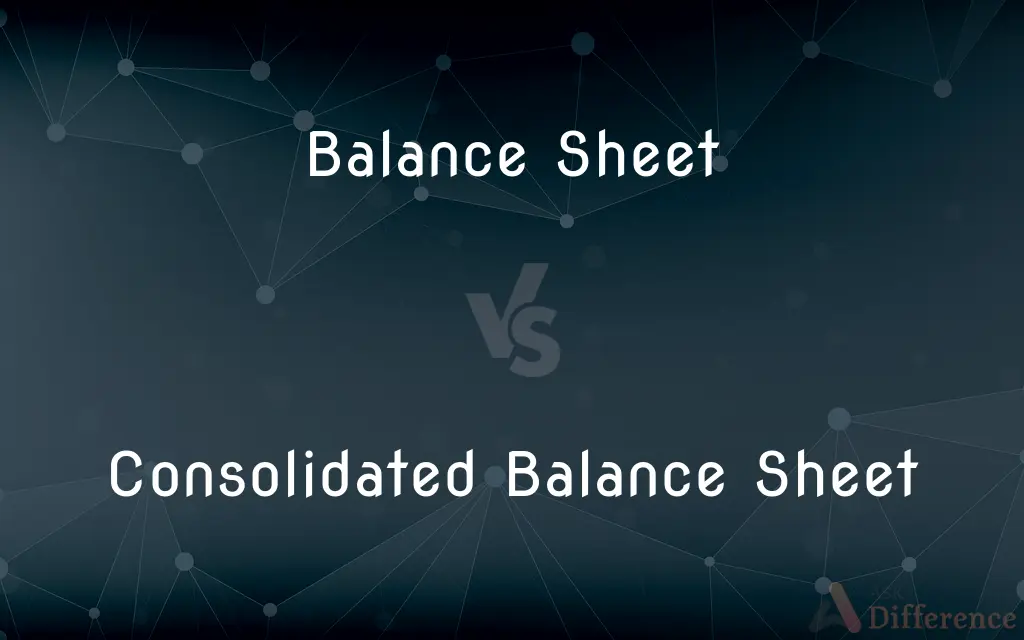Balance Sheet vs. Consolidated Balance Sheet — What's the Difference?
By Tayyaba Rehman — Published on October 3, 2023
A Balance Sheet presents a company's financial position at a single point in time, while a Consolidated Balance Sheet aggregates the financial position of a parent company and its subsidiaries.

Difference Between Balance Sheet and Consolidated Balance Sheet
Table of Contents
ADVERTISEMENT
Key Differences
A Balance Sheet is a critical financial statement representing the financial position of a single entity on a specific date. It consists of assets, liabilities, and equity, abiding by the equation: Assets = Liabilities + Equity. This statement is paramount in assessing an entity's financial health and liquidity, depicting what the entity owns and owes.
On the other hand, a Consolidated Balance Sheet is an extensive financial statement that combines the Balance Sheets of a parent company and its subsidiaries. It gives a comprehensive view of the combined companies' financial status, providing insights into the total assets, liabilities, and equity of the whole corporate group, removing intercompany transactions and balances.
The Balance Sheet is imperative for stakeholders interested in a single entity's financial condition. Investors, creditors, and management use it to make informed decisions regarding the company’s financial stability, analyzing aspects like liquidity, solvency, and capital structure of that particular entity.
Conversely, the Consolidated Balance Sheet serves stakeholders analyzing the financial state of a group of companies operating under a single umbrella. It is vital for assessing the financial performance and stability of the entire business group, offering a holistic view of the combined financial situation, eliminating the need to review the Balance Sheets of each individual entity.
While both, the Balance Sheet and Consolidated Balance Sheet, provide profound insights into financial positions, their difference lies in scope. The Balance Sheet is confined to one entity, whereas the Consolidated Balance Sheet encompasses a parent company along with all its subsidiaries, portraying a broader financial picture.
ADVERTISEMENT
Comparison Chart
Scope
Pertains to a single entity.
Covers a parent company and its subsidiaries.
User Perspective
Offers insights into the financial status of one entity.
Provides a holistic view of the entire corporate group.
Detail Level
Contains detailed information about one entity's assets, liabilities, and equity.
Summarizes combined assets, liabilities, and equity of all entities, eliminating intercompany transactions.
Purpose
To analyze the financial position of a single company.
To assess the collective financial position of a group of companies.
Level of Complexity
Simpler, focusing on individual company accounts.
More complex, consolidating multiple entities’ accounts.
Compare with Definitions
Balance Sheet
A summary that reflects a company's financial status and operations efficacy.
The Balance Sheet’s accuracy is crucial as it forms the basis for financial planning and strategy formulation.
Consolidated Balance Sheet
A summarized financial snapshot portraying a group of companies' collective assets, liabilities, and equity.
Through the Consolidated Balance Sheet, stakeholders can assess the financial synergy within the corporate group.
Balance Sheet
A snapshot of what a company owns and owes at a given moment.
Analysts often scrutinize the Balance Sheet to assess a company’s liquidity and financial stability.
Consolidated Balance Sheet
An integrated financial statement offering insights into the overall economic status of a corporate group.
A meticulous review of the Consolidated Balance Sheet is crucial for stakeholders interested in the financial conglomerate’s aggregate performance.
Balance Sheet
An essential report providing insights into a company's financial health and value.
Investors use the Balance Sheet to evaluate whether a company is a safe investment.
Consolidated Balance Sheet
A financial statement amalgamating the assets, liabilities, and equity of a parent company and its subsidiaries.
The Consolidated Balance Sheet showed the aggregated financial status of the corporate group, aiding in holistic analysis.
Balance Sheet
A document representing the equation: Assets = Liabilities + Equity.
By examining the Balance Sheet, creditors can determine a company’s ability to meet its short-term obligations.
Consolidated Balance Sheet
A comprehensive representation of the combined financial position of a parent and its subsidiary entities.
Investors often refer to the Consolidated Balance Sheet to understand the overall financial health of a multi-entity corporation.
Balance Sheet
A financial statement displaying a company's assets, liabilities, and equity at a specific point in time.
The Balance Sheet revealed that the company’s liabilities exceeded its assets, indicating solvency issues.
Consolidated Balance Sheet
A document reflecting the aggregation of financial information, eliminating intercompany transactions, and displaying a unified financial position.
Analysts find the Consolidated Balance Sheet useful for evaluating the net financial standing of a conglomerate.
Common Curiosities
Who uses Consolidated Balance Sheets?
Consolidated Balance Sheets are used by investors, analysts, and company management to assess the overall financial condition of a corporate group.
Why are Balance Sheets important?
Balance Sheets are crucial as they provide detailed insights into a company's financial health, liquidity, and stability.
What is a Consolidated Balance Sheet?
A Consolidated Balance Sheet combines the financial statements of a parent company and its subsidiaries, presenting a holistic view of their financial position.
Can the Balance Sheet indicate a company’s profitability?
No, a Balance Sheet reflects financial position; the Income Statement shows profitability.
Do all conglomerates prepare Consolidated Balance Sheets?
Yes, conglomerates usually prepare Consolidated Balance Sheets to present the financial state of the entire group of companies.
How often are Balance Sheets prepared?
Balance Sheets are typically prepared annually, but can be prepared more frequently, e.g., quarterly.
What is a Balance Sheet?
A Balance Sheet is a financial statement showing a company's assets, liabilities, and equity at a specific date.
What’s the significance of a Consolidated Balance Sheet for investors?
It provides investors with a comprehensive view of the financial stability and performance of a corporate group, aiding investment decisions.
Can Balance Sheet analysis reveal operational efficiency?
Indirectly, by analyzing asset utilization and liability management, one can infer aspects of operational efficiency.
How do Consolidated Balance Sheets handle intercompany transactions?
Intercompany transactions are eliminated to avoid double counting in Consolidated Balance Sheets.
Is it mandatory for companies to prepare a Balance Sheet?
Yes, companies are generally required by law to prepare Balance Sheets annually for financial reporting.
Can a Balance Sheet provide future financial projections?
No, a Balance Sheet represents the financial position at a specific point in time; it doesn't project future financial conditions.
Is preparing a Consolidated Balance Sheet complex?
Yes, it can be complex due to the integration of multiple entities’ financial statements and elimination of intercompany transactions.
Can a Consolidated Balance Sheet reflect individual subsidiary performance?
No, it reflects the aggregated financial position of the parent and its subsidiaries, not individual performance.
How does one interpret a Balance Sheet?
Interpretation involves analyzing assets, liabilities, and equity to assess liquidity, solvency, and financial stability.
Share Your Discovery

Previous Comparison
Barricade vs. Blockade
Next Comparison
Moisturizer vs. CreamAuthor Spotlight
Written by
Tayyaba RehmanTayyaba Rehman is a distinguished writer, currently serving as a primary contributor to askdifference.com. As a researcher in semantics and etymology, Tayyaba's passion for the complexity of languages and their distinctions has found a perfect home on the platform. Tayyaba delves into the intricacies of language, distinguishing between commonly confused words and phrases, thereby providing clarity for readers worldwide.
















































